MN503: Overview of Internetworking - Report on Networking
VerifiedAdded on 2023/06/10
|7
|1771
|414
Report
AI Summary
This report provides a comprehensive overview of internetworking, tracing its evolution from the early days of computer networks to the present and beyond. It begins by exploring the historical context, highlighting key milestones like the SAGE system and the development of the TCP/IP protocol. The report then delves into the current state of internetworking, focusing on IP routing, comparing static and dynamic routing methods, and discussing their respective advantages and disadvantages. A detailed analysis of the pros and cons of static and dynamic routing is provided. Furthermore, the report examines the rapid growth of internet speeds and the impact of this advancement. The report concludes with a discussion of the future of networking, including emerging technologies like SDN, cloud computing, IoT, machine learning, and AI, emphasizing their potential to revolutionize the field and highlighting the increasing importance of networking in various aspects of modern life.

Running head: INTERNETWORKING
Internetworking
Name of the Student
Name of the University
Author note
Internetworking
Name of the Student
Name of the University
Author note
Paraphrase This Document
Need a fresh take? Get an instant paraphrase of this document with our AI Paraphraser

1INTERNETWORKING
Introduction
A computer network can be explained as collection computer systems along with other
hardware components that are interconnected by communication channels which allows the
systems to share resources among each other’s. This was one of the major inventions in the year of
the 1940. The first step towards the invention was made up by the Gorge Sibitz , when he made a
machine which was used for the purpose of sending a telecode problem in the Dartmouth college[1].
Since then many of the changes have been made in networking and now it has become so fast that
huge amount of data can be send in a moment from one place to other.
History
The concept of the networking came into existence since the beginning of when the
computer systems have been made. But major changes came into existence since the 1950s when
the early networks of the computer were included by the military radar systems at the semi-
automatic ground levels which is popularly known as the SAGE [3]. In the year of the 1960 a system
was made in such a way that passengers were able to book online airline tickets. This became a
revolution turning point for the history of the networking since then many changes began to come
up and latest and more advanced technologies [2]. By the year of the 1964 Massachusetts institute
in collaboration with the Bell labs made a system that enabled routing of the telephone system to
route and telephone connections. Then after in the year of the 1972 many of the changes were
made using the services of the x.25 and the TCP/IP networks.
Present:
Nowadays, the technology has evolved to a point where files can be sent through to any
system of the world with just a one click. The complexity around the networking has been also
increased with the introduction of internet routing. Internet protocol standardizes the way machine
over the IP network or internet route or forward the packets based on the IP address [4]. Along with
addressing, the IP routing is the set of protocols assist to determine the data flow path to travel
across the network from the source to its destination. Currently, there are two types of routing
process as known as static routing and dynamic routing. In static routing, the destination and the
path for sending or receiving the packets are manually configured statically in a router. Where in
dynamic routing a routing protocol such as ISIS, EIGRP, BGP and OSPF is used to configure traffic
across the network.
IP Routing Pros cons
Introduction
A computer network can be explained as collection computer systems along with other
hardware components that are interconnected by communication channels which allows the
systems to share resources among each other’s. This was one of the major inventions in the year of
the 1940. The first step towards the invention was made up by the Gorge Sibitz , when he made a
machine which was used for the purpose of sending a telecode problem in the Dartmouth college[1].
Since then many of the changes have been made in networking and now it has become so fast that
huge amount of data can be send in a moment from one place to other.
History
The concept of the networking came into existence since the beginning of when the
computer systems have been made. But major changes came into existence since the 1950s when
the early networks of the computer were included by the military radar systems at the semi-
automatic ground levels which is popularly known as the SAGE [3]. In the year of the 1960 a system
was made in such a way that passengers were able to book online airline tickets. This became a
revolution turning point for the history of the networking since then many changes began to come
up and latest and more advanced technologies [2]. By the year of the 1964 Massachusetts institute
in collaboration with the Bell labs made a system that enabled routing of the telephone system to
route and telephone connections. Then after in the year of the 1972 many of the changes were
made using the services of the x.25 and the TCP/IP networks.
Present:
Nowadays, the technology has evolved to a point where files can be sent through to any
system of the world with just a one click. The complexity around the networking has been also
increased with the introduction of internet routing. Internet protocol standardizes the way machine
over the IP network or internet route or forward the packets based on the IP address [4]. Along with
addressing, the IP routing is the set of protocols assist to determine the data flow path to travel
across the network from the source to its destination. Currently, there are two types of routing
process as known as static routing and dynamic routing. In static routing, the destination and the
path for sending or receiving the packets are manually configured statically in a router. Where in
dynamic routing a routing protocol such as ISIS, EIGRP, BGP and OSPF is used to configure traffic
across the network.
IP Routing Pros cons
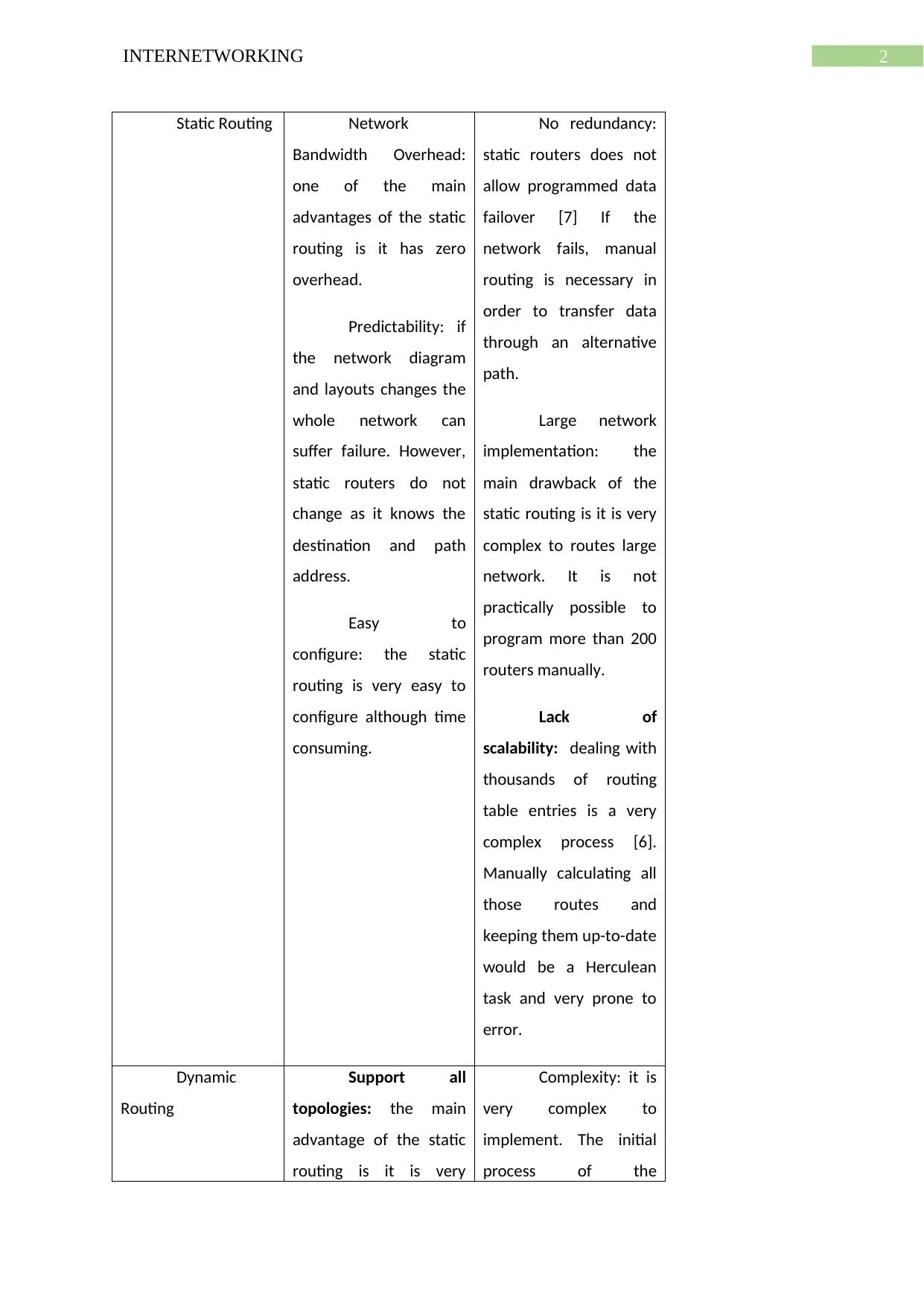
2INTERNETWORKING
Static Routing Network
Bandwidth Overhead:
one of the main
advantages of the static
routing is it has zero
overhead.
Predictability: if
the network diagram
and layouts changes the
whole network can
suffer failure. However,
static routers do not
change as it knows the
destination and path
address.
Easy to
configure: the static
routing is very easy to
configure although time
consuming.
No redundancy:
static routers does not
allow programmed data
failover [7] If the
network fails, manual
routing is necessary in
order to transfer data
through an alternative
path.
Large network
implementation: the
main drawback of the
static routing is it is very
complex to routes large
network. It is not
practically possible to
program more than 200
routers manually.
Lack of
scalability: dealing with
thousands of routing
table entries is a very
complex process [6].
Manually calculating all
those routes and
keeping them up-to-date
would be a Herculean
task and very prone to
error.
Dynamic
Routing
Support all
topologies: the main
advantage of the static
routing is it is very
Complexity: it is
very complex to
implement. The initial
process of the
Static Routing Network
Bandwidth Overhead:
one of the main
advantages of the static
routing is it has zero
overhead.
Predictability: if
the network diagram
and layouts changes the
whole network can
suffer failure. However,
static routers do not
change as it knows the
destination and path
address.
Easy to
configure: the static
routing is very easy to
configure although time
consuming.
No redundancy:
static routers does not
allow programmed data
failover [7] If the
network fails, manual
routing is necessary in
order to transfer data
through an alternative
path.
Large network
implementation: the
main drawback of the
static routing is it is very
complex to routes large
network. It is not
practically possible to
program more than 200
routers manually.
Lack of
scalability: dealing with
thousands of routing
table entries is a very
complex process [6].
Manually calculating all
those routes and
keeping them up-to-date
would be a Herculean
task and very prone to
error.
Dynamic
Routing
Support all
topologies: the main
advantage of the static
routing is it is very
Complexity: it is
very complex to
implement. The initial
process of the
⊘ This is a preview!⊘
Do you want full access?
Subscribe today to unlock all pages.

Trusted by 1+ million students worldwide
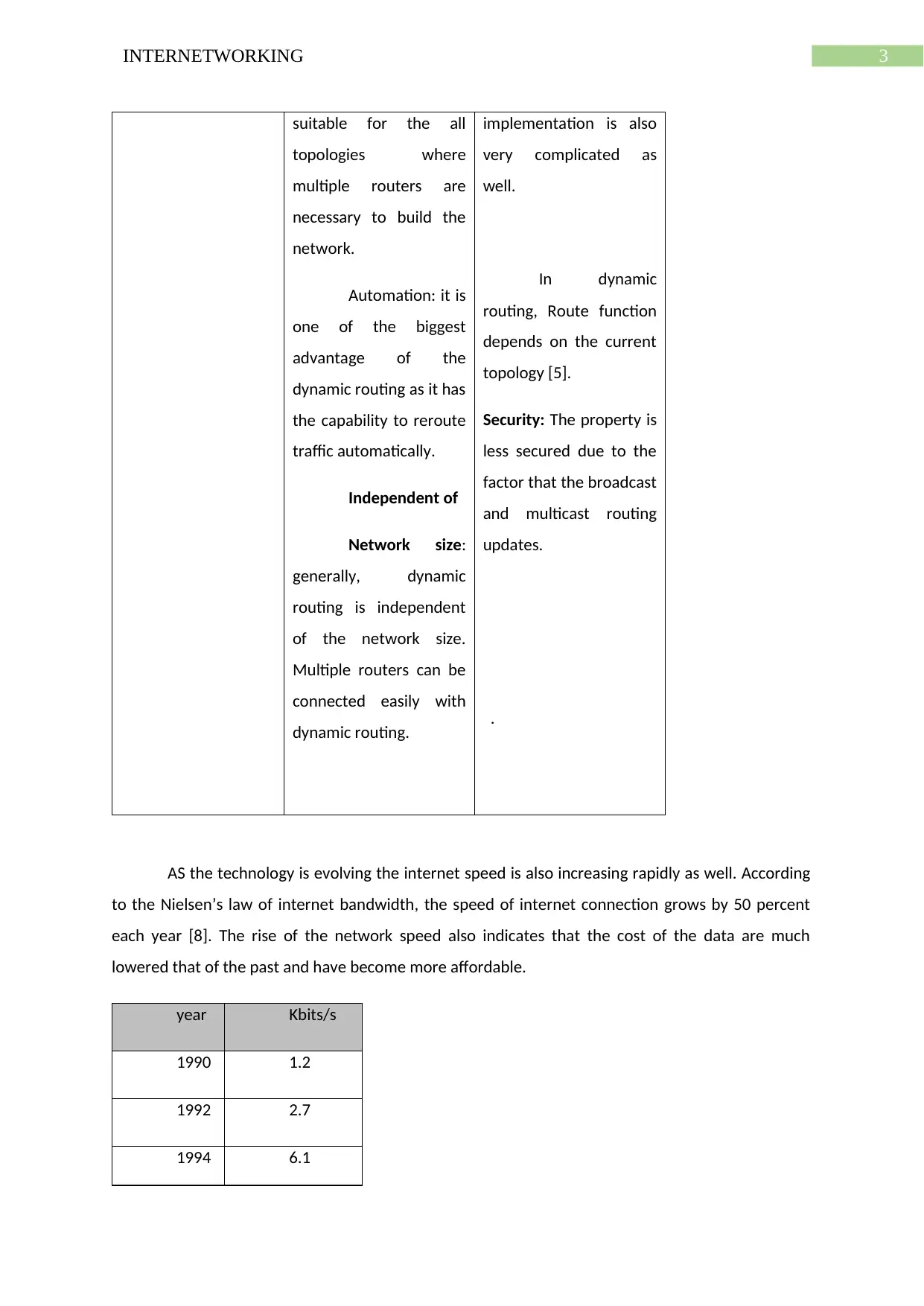
3INTERNETWORKING
suitable for the all
topologies where
multiple routers are
necessary to build the
network.
Automation: it is
one of the biggest
advantage of the
dynamic routing as it has
the capability to reroute
traffic automatically.
Independent of
Network size:
generally, dynamic
routing is independent
of the network size.
Multiple routers can be
connected easily with
dynamic routing.
implementation is also
very complicated as
well.
In dynamic
routing, Route function
depends on the current
topology [5].
Security: The property is
less secured due to the
factor that the broadcast
and multicast routing
updates.
.
AS the technology is evolving the internet speed is also increasing rapidly as well. According
to the Nielsen’s law of internet bandwidth, the speed of internet connection grows by 50 percent
each year [8]. The rise of the network speed also indicates that the cost of the data are much
lowered that of the past and have become more affordable.
year Kbits/s
1990 1.2
1992 2.7
1994 6.1
suitable for the all
topologies where
multiple routers are
necessary to build the
network.
Automation: it is
one of the biggest
advantage of the
dynamic routing as it has
the capability to reroute
traffic automatically.
Independent of
Network size:
generally, dynamic
routing is independent
of the network size.
Multiple routers can be
connected easily with
dynamic routing.
implementation is also
very complicated as
well.
In dynamic
routing, Route function
depends on the current
topology [5].
Security: The property is
less secured due to the
factor that the broadcast
and multicast routing
updates.
.
AS the technology is evolving the internet speed is also increasing rapidly as well. According
to the Nielsen’s law of internet bandwidth, the speed of internet connection grows by 50 percent
each year [8]. The rise of the network speed also indicates that the cost of the data are much
lowered that of the past and have become more affordable.
year Kbits/s
1990 1.2
1992 2.7
1994 6.1
Paraphrase This Document
Need a fresh take? Get an instant paraphrase of this document with our AI Paraphraser
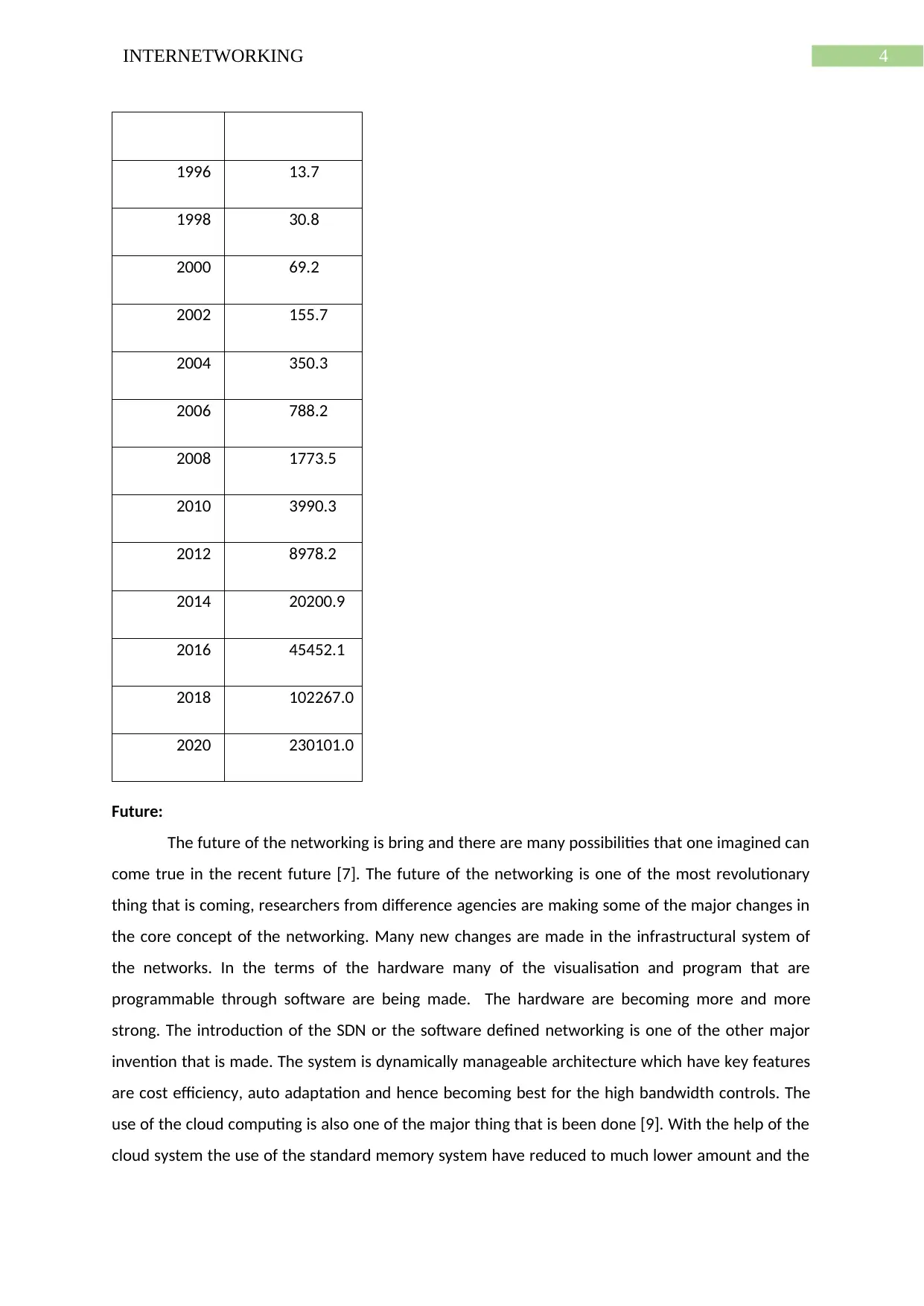
4INTERNETWORKING
1996 13.7
1998 30.8
2000 69.2
2002 155.7
2004 350.3
2006 788.2
2008 1773.5
2010 3990.3
2012 8978.2
2014 20200.9
2016 45452.1
2018 102267.0
2020 230101.0
Future:
The future of the networking is bring and there are many possibilities that one imagined can
come true in the recent future [7]. The future of the networking is one of the most revolutionary
thing that is coming, researchers from difference agencies are making some of the major changes in
the core concept of the networking. Many new changes are made in the infrastructural system of
the networks. In the terms of the hardware many of the visualisation and program that are
programmable through software are being made. The hardware are becoming more and more
strong. The introduction of the SDN or the software defined networking is one of the other major
invention that is made. The system is dynamically manageable architecture which have key features
are cost efficiency, auto adaptation and hence becoming best for the high bandwidth controls. The
use of the cloud computing is also one of the major thing that is been done [9]. With the help of the
cloud system the use of the standard memory system have reduced to much lower amount and the
1996 13.7
1998 30.8
2000 69.2
2002 155.7
2004 350.3
2006 788.2
2008 1773.5
2010 3990.3
2012 8978.2
2014 20200.9
2016 45452.1
2018 102267.0
2020 230101.0
Future:
The future of the networking is bring and there are many possibilities that one imagined can
come true in the recent future [7]. The future of the networking is one of the most revolutionary
thing that is coming, researchers from difference agencies are making some of the major changes in
the core concept of the networking. Many new changes are made in the infrastructural system of
the networks. In the terms of the hardware many of the visualisation and program that are
programmable through software are being made. The hardware are becoming more and more
strong. The introduction of the SDN or the software defined networking is one of the other major
invention that is made. The system is dynamically manageable architecture which have key features
are cost efficiency, auto adaptation and hence becoming best for the high bandwidth controls. The
use of the cloud computing is also one of the major thing that is been done [9]. With the help of the
cloud system the use of the standard memory system have reduced to much lower amount and the
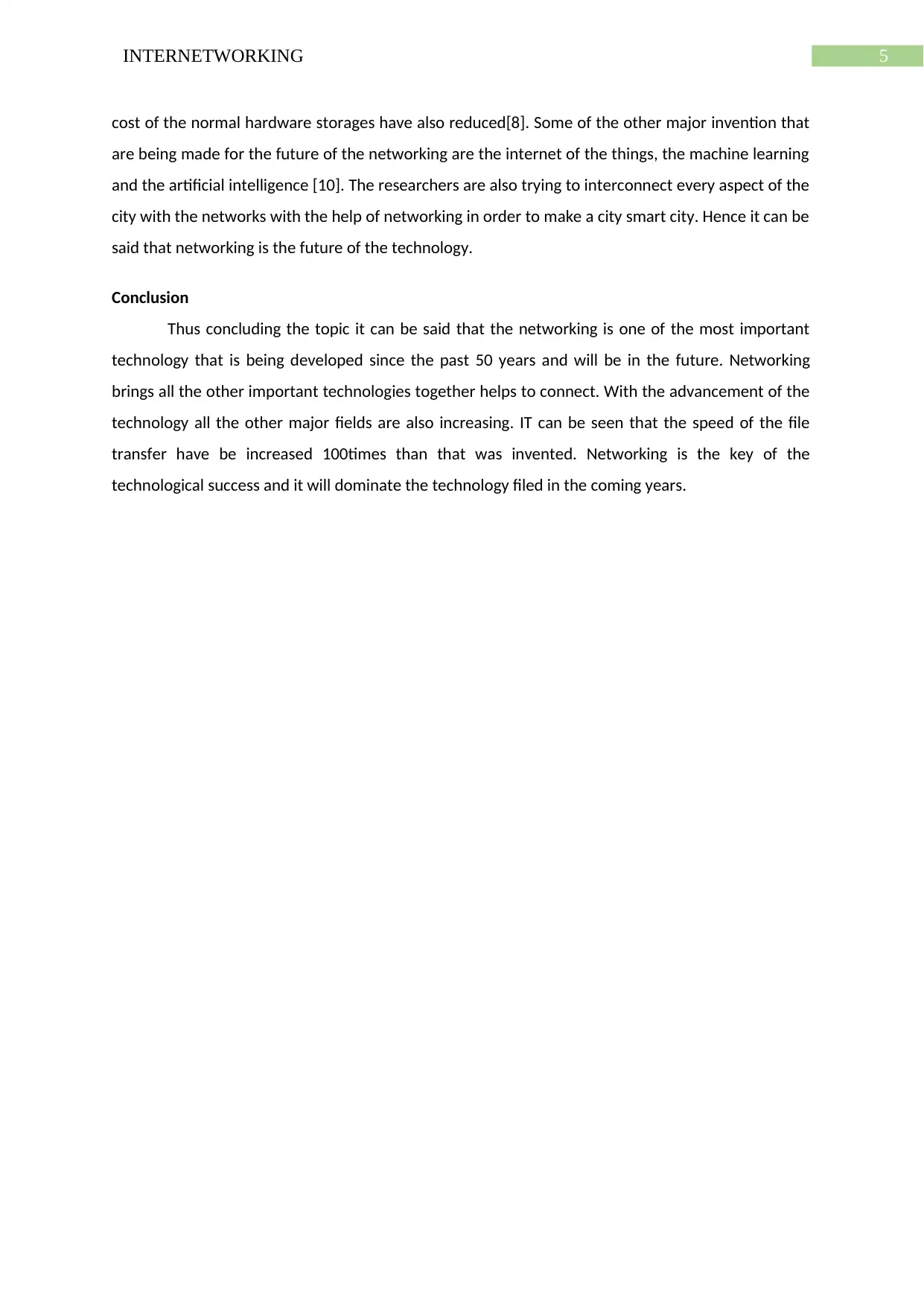
5INTERNETWORKING
cost of the normal hardware storages have also reduced[8]. Some of the other major invention that
are being made for the future of the networking are the internet of the things, the machine learning
and the artificial intelligence [10]. The researchers are also trying to interconnect every aspect of the
city with the networks with the help of networking in order to make a city smart city. Hence it can be
said that networking is the future of the technology.
Conclusion
Thus concluding the topic it can be said that the networking is one of the most important
technology that is being developed since the past 50 years and will be in the future. Networking
brings all the other important technologies together helps to connect. With the advancement of the
technology all the other major fields are also increasing. IT can be seen that the speed of the file
transfer have be increased 100times than that was invented. Networking is the key of the
technological success and it will dominate the technology filed in the coming years.
cost of the normal hardware storages have also reduced[8]. Some of the other major invention that
are being made for the future of the networking are the internet of the things, the machine learning
and the artificial intelligence [10]. The researchers are also trying to interconnect every aspect of the
city with the networks with the help of networking in order to make a city smart city. Hence it can be
said that networking is the future of the technology.
Conclusion
Thus concluding the topic it can be said that the networking is one of the most important
technology that is being developed since the past 50 years and will be in the future. Networking
brings all the other important technologies together helps to connect. With the advancement of the
technology all the other major fields are also increasing. IT can be seen that the speed of the file
transfer have be increased 100times than that was invented. Networking is the key of the
technological success and it will dominate the technology filed in the coming years.
⊘ This is a preview!⊘
Do you want full access?
Subscribe today to unlock all pages.

Trusted by 1+ million students worldwide
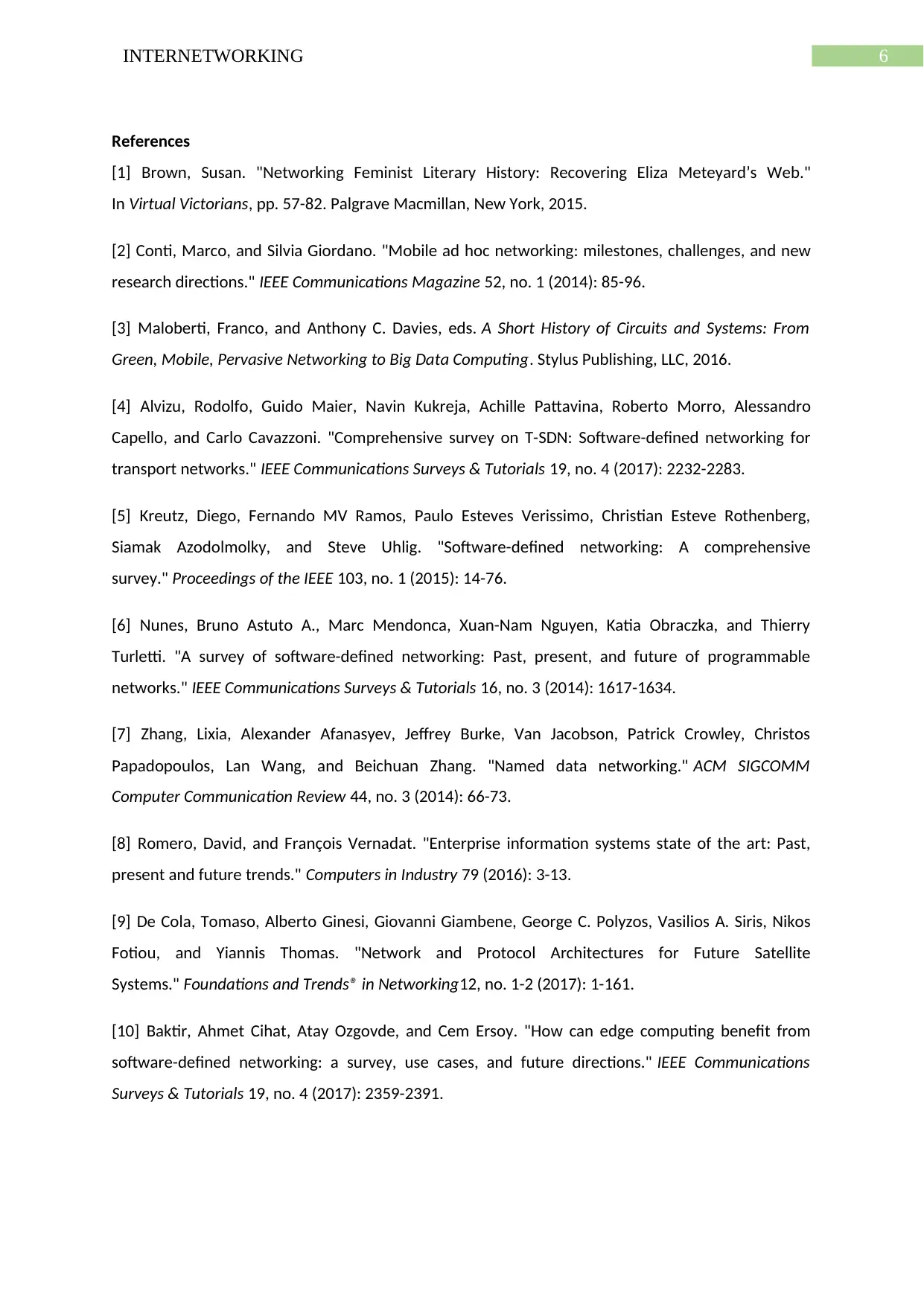
6INTERNETWORKING
References
[1] Brown, Susan. "Networking Feminist Literary History: Recovering Eliza Meteyard’s Web."
In Virtual Victorians, pp. 57-82. Palgrave Macmillan, New York, 2015.
[2] Conti, Marco, and Silvia Giordano. "Mobile ad hoc networking: milestones, challenges, and new
research directions." IEEE Communications Magazine 52, no. 1 (2014): 85-96.
[3] Maloberti, Franco, and Anthony C. Davies, eds. A Short History of Circuits and Systems: From
Green, Mobile, Pervasive Networking to Big Data Computing. Stylus Publishing, LLC, 2016.
[4] Alvizu, Rodolfo, Guido Maier, Navin Kukreja, Achille Pattavina, Roberto Morro, Alessandro
Capello, and Carlo Cavazzoni. "Comprehensive survey on T-SDN: Software-defined networking for
transport networks." IEEE Communications Surveys & Tutorials 19, no. 4 (2017): 2232-2283.
[5] Kreutz, Diego, Fernando MV Ramos, Paulo Esteves Verissimo, Christian Esteve Rothenberg,
Siamak Azodolmolky, and Steve Uhlig. "Software-defined networking: A comprehensive
survey." Proceedings of the IEEE 103, no. 1 (2015): 14-76.
[6] Nunes, Bruno Astuto A., Marc Mendonca, Xuan-Nam Nguyen, Katia Obraczka, and Thierry
Turletti. "A survey of software-defined networking: Past, present, and future of programmable
networks." IEEE Communications Surveys & Tutorials 16, no. 3 (2014): 1617-1634.
[7] Zhang, Lixia, Alexander Afanasyev, Jeffrey Burke, Van Jacobson, Patrick Crowley, Christos
Papadopoulos, Lan Wang, and Beichuan Zhang. "Named data networking." ACM SIGCOMM
Computer Communication Review 44, no. 3 (2014): 66-73.
[8] Romero, David, and François Vernadat. "Enterprise information systems state of the art: Past,
present and future trends." Computers in Industry 79 (2016): 3-13.
[9] De Cola, Tomaso, Alberto Ginesi, Giovanni Giambene, George C. Polyzos, Vasilios A. Siris, Nikos
Fotiou, and Yiannis Thomas. "Network and Protocol Architectures for Future Satellite
Systems." Foundations and Trends® in Networking12, no. 1-2 (2017): 1-161.
[10] Baktir, Ahmet Cihat, Atay Ozgovde, and Cem Ersoy. "How can edge computing benefit from
software-defined networking: a survey, use cases, and future directions." IEEE Communications
Surveys & Tutorials 19, no. 4 (2017): 2359-2391.
References
[1] Brown, Susan. "Networking Feminist Literary History: Recovering Eliza Meteyard’s Web."
In Virtual Victorians, pp. 57-82. Palgrave Macmillan, New York, 2015.
[2] Conti, Marco, and Silvia Giordano. "Mobile ad hoc networking: milestones, challenges, and new
research directions." IEEE Communications Magazine 52, no. 1 (2014): 85-96.
[3] Maloberti, Franco, and Anthony C. Davies, eds. A Short History of Circuits and Systems: From
Green, Mobile, Pervasive Networking to Big Data Computing. Stylus Publishing, LLC, 2016.
[4] Alvizu, Rodolfo, Guido Maier, Navin Kukreja, Achille Pattavina, Roberto Morro, Alessandro
Capello, and Carlo Cavazzoni. "Comprehensive survey on T-SDN: Software-defined networking for
transport networks." IEEE Communications Surveys & Tutorials 19, no. 4 (2017): 2232-2283.
[5] Kreutz, Diego, Fernando MV Ramos, Paulo Esteves Verissimo, Christian Esteve Rothenberg,
Siamak Azodolmolky, and Steve Uhlig. "Software-defined networking: A comprehensive
survey." Proceedings of the IEEE 103, no. 1 (2015): 14-76.
[6] Nunes, Bruno Astuto A., Marc Mendonca, Xuan-Nam Nguyen, Katia Obraczka, and Thierry
Turletti. "A survey of software-defined networking: Past, present, and future of programmable
networks." IEEE Communications Surveys & Tutorials 16, no. 3 (2014): 1617-1634.
[7] Zhang, Lixia, Alexander Afanasyev, Jeffrey Burke, Van Jacobson, Patrick Crowley, Christos
Papadopoulos, Lan Wang, and Beichuan Zhang. "Named data networking." ACM SIGCOMM
Computer Communication Review 44, no. 3 (2014): 66-73.
[8] Romero, David, and François Vernadat. "Enterprise information systems state of the art: Past,
present and future trends." Computers in Industry 79 (2016): 3-13.
[9] De Cola, Tomaso, Alberto Ginesi, Giovanni Giambene, George C. Polyzos, Vasilios A. Siris, Nikos
Fotiou, and Yiannis Thomas. "Network and Protocol Architectures for Future Satellite
Systems." Foundations and Trends® in Networking12, no. 1-2 (2017): 1-161.
[10] Baktir, Ahmet Cihat, Atay Ozgovde, and Cem Ersoy. "How can edge computing benefit from
software-defined networking: a survey, use cases, and future directions." IEEE Communications
Surveys & Tutorials 19, no. 4 (2017): 2359-2391.
1 out of 7
Related Documents
Your All-in-One AI-Powered Toolkit for Academic Success.
+13062052269
info@desklib.com
Available 24*7 on WhatsApp / Email
![[object Object]](/_next/static/media/star-bottom.7253800d.svg)
Unlock your academic potential
Copyright © 2020–2025 A2Z Services. All Rights Reserved. Developed and managed by ZUCOL.


